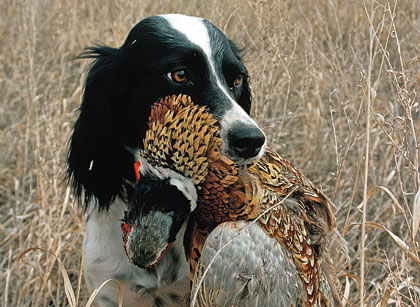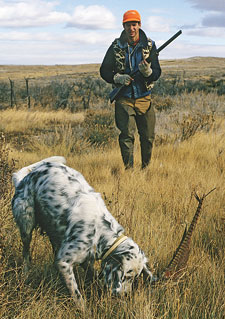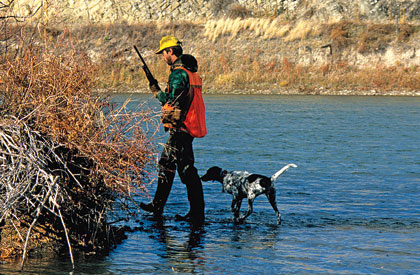Pointers can become great pheasant dogs, but it won't happen overnight.
By Dave Carty
 The author believes in force-breaking his dogs to retrieve, after which most usually come to like fetching big ringnecks. |
Out here in the rugged West, the Labrador retriever is king. Labs are used to hunt anything that flies: ducks, geese, Huns, sharptails and, not incidentally, pheasants. Because if there's one animal the average Westerner likes whacking more than an elk, it's a pheasant. Labs aren't quite the stellar performers in the uplands that they are in the marsh, but there's no denying they get the job done.
But Labs aren't the only pheasant dogs in Big Sky country, and if you toss springer spaniels from consideration--a breed designed by God to handle pheasants but which, for some reason, has never really caught on out West--the two breeds that, by my reckoning, tie for second place in the pheasant-hunting canine popularity polls are both pointers: Brittanys and German shorthairs. There's a reason for that. Despite what you might have heard about pheasants "ruining" a good pointer, pointing dogs and pheasants are a perfectly acceptable match.
Now, it's no secret among my friends that pheasants are down a ways on my list of preferred gamebirds. But that has more to do with the sometimes miserable cover they live in, and the chronic headaches around access to private land, than their penchant for running. I've hunted ruffed grouse and chukars that ran circles around the average ringneck, and Huns and sharptails that flushed at far greater ranges, even after being pointed by one of my dogs. In fact, working a running pheasant over a pointing dog and getting a shot is often dependent more upon what you and your dog don't do than on anything the rooster may throw at you. Here's why: A really good pheasant dog will take everything you've read about training pointers and stand it on its head--if you let him.
Some of the "rules" that have developed around pointing dogs were apparently thought up by the field trial folks, who by and large have done a tremendous amount of good for the American pointing breeds. But that good comes at certain costs, and one of them is the insistence on absolute staunchness at the dog's first whiff of scent.
That's fine at a trial where handlers may not have the time, inclination or patience to follow a creeping pointer for the 10 minutes it takes it to pin a bird, but it's about the last thing you want in a pheasant dog. What good does it do you if your GSP points a bird that is 75 yards away and running by the time you arrive to release him?
 Many pheasant hunters want their dogs to break at flush and be on top of the bird the moment it hits the ground. It's a hard point to argue. |
Permissible Creeping
Instead, let him creep. There, I said it. Let him pussyfoot, slink, crawl and belly-slither until he's as close as he can get. You can't teach a dog to do this; you have to let him figure it out on his own. And you need to have the patience to let him bump a few birds until he gets it right. A curt reprimand following a bumped bird will get the point across, but that's enough. He knows he screwed up.
The argument against letting a dog creep is that he'll do it on every other gamebird, too. I used to believe that; after all, it makes perfect sense. How is a dog supposed to know that bobwhite quail hold and pheasants run? What's missing from that argument is the fact that most gamebirds run. And for the few that don't--bobwhite quail, woodcock, Mearns quail--somehow, the dogs figure it out.
My dogs, which creep and relocate on ruffed grouse, Huns, sharptails, chukars and yes, pheasants, can switch gears on a dime when it comes to pointing tight-sitting Mearns quail, sticking them where they sit, often without so much as an extra step. I've seen dozens of other pointers do the same.
None of the foregoing is to imply for even a moment that your dog shouldn't whoa on command. Once my dogs stop creeping, I'll give them a soft "whoa" if it looks like they've pinned the bird. Most of the time they have; if not, I release them and let them relocate.
Nearly all the people I've trained dogs for hunt pheasants, and some of them have concerns about the birds ruining their dogs. I don't share that concern. Any dog with a season of more forgiving gamebirds under its belt--and that's most gamebirds--and a solid foundation of training should be able to handle a running rooster.
Puppies are a different story. I usually suggest that a young dog's first season be spent on birds that are easier to handle. But if pheasants are all you have, then train your pup well prior to his first season and turn him loose in suitable cover. He'll eventually get his ducks in a row.
Notice I said "suitable" cover. That means grasslands, CRP fields, river bottoms--anything thick enough to hold birds and restrict their running. It does not mean corn or wheat stubble, in which the birds can and often do run unrestricted to the ends of the earth. Turning a pointing dog loose in that stuff, no matter how experienced the dog, borders on a lost cause. Leave the cornfields for the blaze-orange armies and their military drives; they can have them. Instead, round up your dog, perhaps one other friend, and hit the swamps and CRP fields that pheasants seem to love everywhere they live.
 A hunter with a single dog is better off concentrating on thicker, out-of-the-way cover and leaving the cut cornfields to the large drive-and-block parties. |
Retrieving Genes
One of the reasons Labs are so popular is because they retrieve, every inky-black last one of them. You may have noticed that retrieving among the pointing breeds is not so cut and dried. Some love it, but others wouldn't retrieve a dead bird if you wrapped it in prime rib. In the latter case, I'm a strong believer in force-breaking. Afterward, most (although not all) dogs will eventually learn to enjoy retrieving roosters as well as other birds, although few ever reach a Lab's level of hysterical enthusiasm. That's OK. As long as the dog makes a reasonable effort to find and retrieve the birds I shoot, I can live with that.
Occasionally, though, long-dormant retrieving genes rise to the surface, and ou
t of nowhere you'll discover you own a star. One of the best pheasant dogs I ever hunted over belonged to my late friend Datus Proper, author of Pheasants of the Mind, a wonderful, philosophical discourse on pheasants and the dogs and people that hunt them.
Datus wasn't much of a trainer, and his shorthair, Huck, wasn't much for obedience. But the two spent so much time hunting together they developed something like telepathic communication. If Huck didn't return on the whistle--which was most of the time--Datus figured he was on a bird. As often as not, he was.
Huck was also a phenom at retrieving pheasants as well as wounded Huns, the latter of which Datus and I agreed were virtually devoid of scent, unlike the former, which, judging from most dog's reactions, must smell like a pot of south Texas chili. More than once, long after my dogs had given up the chase, Huck would return with a bird in his mouth.
I train my own dogs to be steady to wing, shot and fall no matter what type of bird they're hunting, because I'm anal about things like that, and that's the way I like my dogs. Clients' dogs are another matter. I gave up recommending my own approach when it finally dawned on me that few people I trained dogs for were carrying on with the necessary maintenance to keep their dogs at that level. Instead, I now suggest they let me train their dogs to be steady to flush, which allows them to break at the shot.
 Brittanys are one of the most popular pointing breeds for pheasants, offering moderate range and better-than-average retrieving ability. |
But for certain hardcore pheasant hunters, even that approach is too restrictive. They want their dogs breaking on the flush and on top of the bird the minute it hits the ground, convinced they'll lose it otherwise. With almost any other gamebird, I'd offer a spirited debate. With pheasants, well, they may have a point.
I'm not entirely convinced, mind you, and can make a pretty good argument that a dog broken steady to flush has plenty of time to find a wounded rooster, but I've also seen wing-tipped pheasants fly 200 yards and pull some amazing disappearing routines. Not coincidentally, it is also true that the pheasant bug seems to grip certain folks with a particularly feverish intensity. I have friends who shoot more birds in a year than I'll even see in five. And those guys I don't argue with.
Finally, my two non-negotiable commands for any dog, but particularly for a pheasant dog, are "whoa" and "come." When the day arrives that you drop into a swale and pheasants start blowing out all around you until it seems the world is nothing but cackling roosters and gunfire--lucky you--you'll be glad your dog will return on the whistle when he can't take it any more and decides to chase all those birds into the next county. Then you can calm him down, turn him loose again and see if he can find a stray single.
Watch him good--after all those running birds, he may well pin the very next rooster in its tracks.






